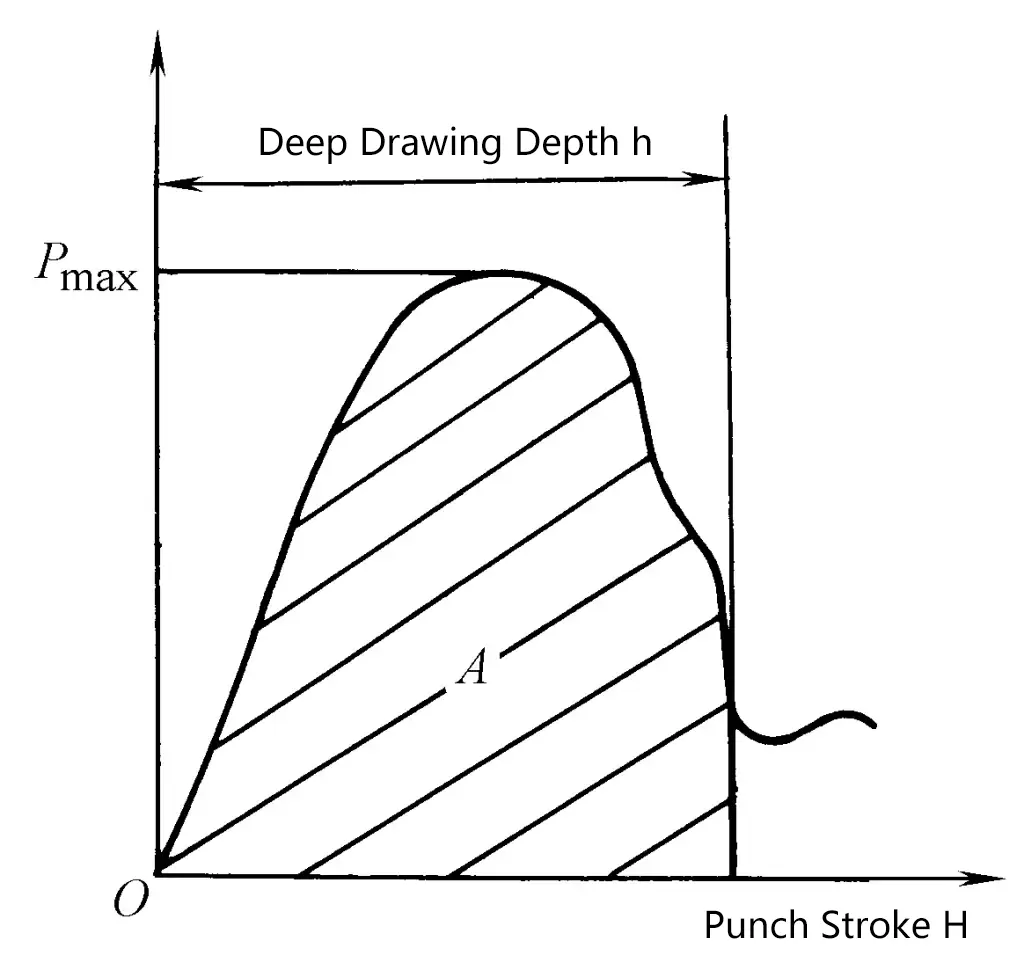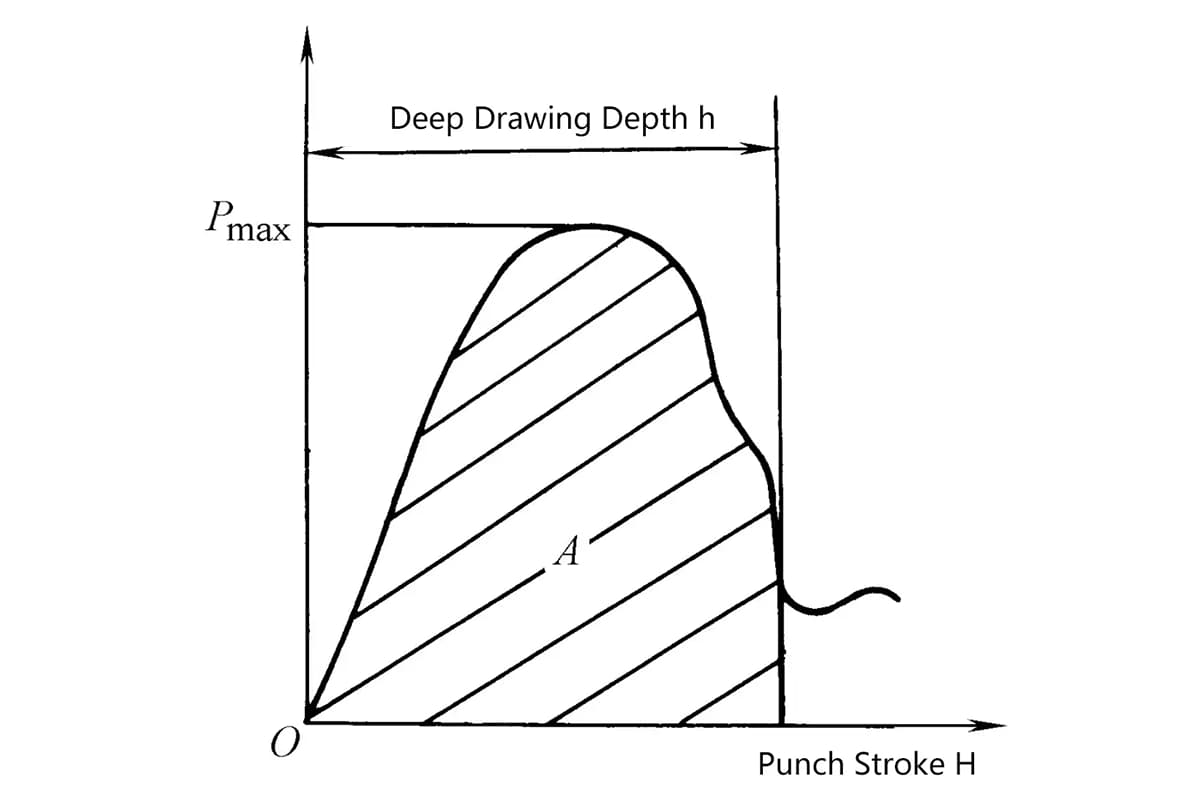I. Deep Drawing Force
Deep drawing force is an important basis for determining the tonnage of the press required for deep drawn parts. In actual production, some empirical formulas are commonly used to determine the deep drawing force.
1. Maximum deep drawing force for cylindrical parts
(1) The drawing force for the first deep drawing
Pmax =πdp1tRmK1
(2) The drawing force for the second and subsequent deep drawings
Pmax =πdp2tRmK2
Where in the formula
- d p1 , d p2 -The diameter of the workpiece after the first and second deep drawing (mm);
- t-Blank thickness (mm);
- R m -Material tensile strength (MPa);
- K 1 , K 2 -Coefficients, refer to Table 1 and Table 2 respectively.
Table 1 Coefficient K 1 for the first deep drawing of cylindrical parts (08 ~15 steel)
| Relative thickness t/D0 ×100 | First deep drawing coefficient m1 | |||||||||
| 0.45 | 0.48 | 0.5 | 0.52 | 0.55 | 0.6 | 0.65 | 0.7 | 0.75 | 0.8 | |
| 5 | 0.95 | 0.85 | 0.75 | 0.65 | 0.6 | 0.5 | 0.43 | 0.35 | 0.28 | 0.2 |
| 2 | 1.1 | 1 | 0.9 | 0.8 | 0.75 | 0.6 | 0.5 | 0.42 | 0.35 | 0.25 |
| 1.2 | 1.1 | 1 | 0.9 | 0.8 | 0.68 | 0.56 | 0.47 | 0.37 | 0.3 | |
| 0.8 | 1.1 | 1 | 0.9 | 0.75 | 0.6 | 0.5 | 0.4 | 0.33 | ||
| 0.5 | 1.1 | 1 | 0.82 | 0.67 | 0.55 | 0.45 | 0.36 | |||
| 0.2 | 1.1 | 0.9 | 0.75 | 0.6 | 0.5 | 0.4 | ||||
| 0.1 | 1.1 | 0.9 | 0.75 | 0.6 | 0.5 | |||||
Note: 1. When the punch radius rp = (4 ~6)t, the coefficient K1 should be increased by 5% according to the table values.
2. For other materials, correct the lookup values according to the change in material plasticity (increase as plasticity decreases).
Table 2 Coefficient K 2 value for the second deep drawing of cylindrical parts (08 ~15 steel)
| Relative thickness t/D0 ×100 | Coefficient m2 for the first deep drawing | |||||||||
| 0.7 | 0.72 | 0.75 | 0.78 | 0.8 | 0.82 | 0.85 | 0.88 | 0.9 | 0.92 | |
| 5 | 0.85 | 0.7 | 0.6 | 0.5 | 0.42 | 0.32 | 0.28 | 0.2 | 0.15 | 0.12 |
| 2 | 1.1 | 0.9 | 0.75 | 0.6 | 0.52 | 0.42 | 0.32 | 0.25 | 0.2 | 0.14 |
| 1.2 | 1.1 | 0.9 | 0.75 | 0.62 | 0.52 | 0.42 | 0.3 | 0.25 | 0.16 | |
| 0.8 | 1 | 0.82 | 0.7 | 0.57 | 0.46 | 0.35 | 0.27 | 0.18 | ||
| 0.5 | 1.1 | 0.9 | 0.76 | 0.63 | 0.5 | 0.4 | 0.3 | 0.2 | ||
| 0.2 | 1 | 0.85 | 0.7 | 0.56 | 0.44 | 0.33 | 0.23 | |||
| 0.1 | 1.1 | 1 | 0.82 | 0.68 | 0.55 | 0.4 | 0.3 | |||
Note:
1. When the punch radius r p = (4~6)t, the K 2 value in the table should be increased by 5%.
2. For the coefficients K 2 of the 3rd, 4th, and 5th deep drawing, the corresponding m n and t/D 0 ×100 values are found from the same table, but the larger or smaller value in the table should be chosen based on whether there is an intermediate annealing process:
Without intermediate annealing, K 2 takes the larger value (closer to the one below);
With intermediate annealing, K 2 takes the smaller value (closer to the one above).
3. For other materials, correct the lookup values according to the change in material plasticity (increase as plasticity decreases).
2. Deep drawing force for flanged parts
(1) First drawing force of flanged cylindrical parts
Pmax =πdptRmKF
(2) First maximum drawing force of flanged conical parts and spherical shell parts
Pmax =πdKtRmKF
Where in the formula
- d p -Diameter of the cylindrical part (mm);
- d K -Minimum diameter of the conical part (top diameter of the cone), or the radius of the spherical shell (mm);
- K F -Coefficient, refer to Table 3.
Table 3 Coefficient K F values for the first drawing of flanged drawn parts (08 to 15 steel)
| dF/dP | Drawing coefficient d p /D 0 | ||||||||||
| 0.35 | 0.38 | 0.4 | 0.42 | 0.45 | 0.5 | 0.55 | 0.6 | 0.65 | 0.7 | 0.75 | |
| 3 | 1 | 0.9 | 0.83 | 0.75 | 0.68 | 0.56 | 0.45 | 0.37 | 0.3 | 0.23 | 0.18 |
| 2.8 | 1.1 | 1 | 0.9 | 0.83 | 0.75 | 0.62 | 0.5 | 0.42 | 0.34 | 0.26 | 0.2 |
| 2.5 | 1.1 | 1 | 0.9 | 0.82 | 0.7 | 0.56 | 0.46 | 0.37 | 0.3 | 0.22 | |
| 2.2 | 1.1 | 1 | 0.9 | 0.77 | 0. 64 | 0.52 | 0.42 | 0.33 | 0.25 | ||
| 2 | 1.1 | 1 | 0.85 | 0.7 | 0.58 | 0.47 | 0.37 | 0.28 | |||
| 1.8 | 1.1 | 0.95 | 0.8 | 0.65 | 0.53 | 0.43 | 0.33 | ||||
| 1.5 | 1.1 | 0.9 | 0.75 | 0.62 | 0.5 | 0.4 | |||||
| 1.3 | 1 | 0.85 | 0.7 | 0.56 | 0.45 | ||||||
Note: When flanging, the value of K F increases by 10% to 20%.
3. Drawing force for thinning drawing (cylindrical parts)
P max =πd n (t n-1 -t n )R m K 3
Where in the formula
- d n -Outer diameter of the cylinder (mm);
- t n-1 , t n – Wall thickness of the front and rear cylinders before and after thinning and deep drawing (mm);
- K 3 – Coefficient, steel is 1.8~2.25; brass is 1.6~1.8.
II. Deep Drawing Work and Power
1. Deep Drawing Work
Deep drawing work is also one of the important bases for selecting a press. The pressure load of the press is limited by the strength of the crankshaft or transmission gears, while the power load is limited by the kinetic energy of the flywheel, the power of the motor, or its allowable overload level. Therefore, when selecting a press, both the magnitude of the pressure and the work should be considered comprehensively.
(1) Deep drawing work of cylindrical parts
The relationship between deep drawing force and the working stroke of the punch is shown in Figure 1. The deep drawing work should be the area under the curve (shaded part). For convenience of calculation, the following empirical formula is used to calculate the deep drawing work
A=cPmaxh×l0-3
Where in the formula
- A- Deep drawing work (J);
- P max – Maximum deep drawing force (N);
- h- Depth of deep drawing (mm);
- c-coefficient, related to the deep drawing coefficient, refer to Table 4.

Table 4 Relationship between coefficient c and deep drawing coefficient
| Deep drawing coefficient m | 0.55 | 0.6 | 0.65 | 0.7 | 0.75 | 0.8 |
| Coefficient c | 0.8 | 0.77 | 0.74 | 0.7 | 0.67 | 0.64 |
(2) Deep drawing work for thinning
A=Pmaxh×1.2×l0-3
where
- P max – Maximum deep drawing force for thinning deep drawing (N);
- h – Deep drawing depth (mm);
- 1.2 – Safety factor.
2. Power
The power of the press motor is calculated by the following formula
P=KA n /(1.36×60×750×η 1 ×η 2 )
where
- P – Power of the press motor (kW);
- K – Unbalance coefficient, K=1.2~1.4;
- A – Deep drawing power (J);
- η 1 – Efficiency of the press, 71=0.6~0.8;
- η 2 – Motor efficiency, 72=0.9~0.95;
- n – Number of strokes per minute of the press;
- 1.36 – Conversion factor, from horsepower to kilowatts.

